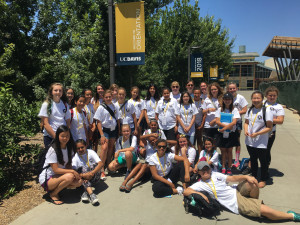
Incoming seventh and eighth-graders at Benicia Middle School participated in UC Davis’ CSTEM GIRL Camp from June 27 to July 1. The camp was held at Robert Semple Elementary, but the group also took a study trip to UC Davis’ campus where they experienced college life firsthand. (Photo courtesy of Stephanie Rice)
Education plays a big role in determining students’ futures. As they move through their schooling, students take at least one class that inspires them to enter that field or influences what they want to do with their lives. Additionally, as technology becomes more omnipresent, more career opportunities open up for everybody. Therefore, it has become expected for schools to inspire students—especially female students— to enter the fields they are most passionate about, not necessarily the ones society has traditionally suggested they take.
This was the premise behind C-STEM GIRL (Girls in Robotic Leadership) Camp, a weeklong partnership between Benicia Unified School District and UC Davis, in which incoming seventh and eighth-grade girls learned about robotics and coding as well as leadership, public speaking and team building skills. The camp was held from Monday, June 27 to Friday, July 1 at Robert Semple Elementary School, and the goal was to generate enthusiasm among middle school girls for CSTEM (Computing, Science, Technology, Engineering and Mathematics).
Stephanie Rice, the camp coordinator and a teacher on special assignment for Benicia Unified’s educational services department, says providing CSTEM opportunities for students is a top priority for Benicia Unified, and the department was looking for new ways to promote CSTEM.
“While researching, we found this camp opportunity through the CSTEM Department at UC Davis,” she said. “UC Davis hosts several camps at the college as well as gives the opportunity for districts to be host sites. We thought this would be a great camp to pilot the idea and see what interest there was for such a camp.”
Rice says a big goal is to get more girls interested in computing and robotics. As the New York Times noted in a 2013 article, even as women take more jobs in law, business, chemistry and biology, only 5.7 percent of employed women in the United States work in the computer industry, and only 2 percent work in a high-tech field.
“Concerning the global economy, if the U.S. wants to be competitive in technology development and provide an equal opportunity for half its population, the gender gap in engineering and technology needs to be closed,” Judy Davis and Harry Cheng wrote in a paper about UC Davis’ C-STEM Camp.
Despite a heavy focus on girls, Rice said the camp would not be closed to boys either.
Over the course of one week, students learned how to write code– which they used to maneuver robots they created through obstacle courses– and created videos on iMovie. They also had guest speeches from Kaiser Permanente web designer Deb Lyons to discuss the field of web design, and Benicia High School robotics teacher Andreas Kaiser to talk about computing classes available at the high school. The group also took a study trip to UC Davis where members of the Early Academic Outreach program explained what it was like to go to college, and they received tours from UC Davis students Ada Liu and Annie Tu. Additionally, Benicia High School math teacher Lee Anne Aidt served as a teacher mentor to the campers.
Rice said the students got along great, even though for many it was their first time meeting.
“The students seemed eager to get to work each day and when told it was time to clean up to go, they always asked for a few more minutes,” she said. “A common comment from the students was they didn’t want the camp to end.”
Rice hopes the camp was a memorable, useful experience for all involved.
“Our hope was to ignite an interest for coding and robotics,” she said. “We wanted students to build confidence in their leadership and presentation skills and make connections between technology, math, science, and the arts. We hoped that students would make friendships and connections with other students that share the interest of learning about coding and robotics.”
Most of all, Rice was proud of the risks the campers took and the skills they gained.
“I commented to the parents what an impressive job they did all week from working in teams, taking a risk to present in front of others and not only identifying problems in the world but seeking solutions with the help of their knowledge in robotics,” she said. “These young ladies are our future, and what a bright future I foresee if they are a representation of our up-and-coming adults in the next five to seven years.”






Leave a Reply